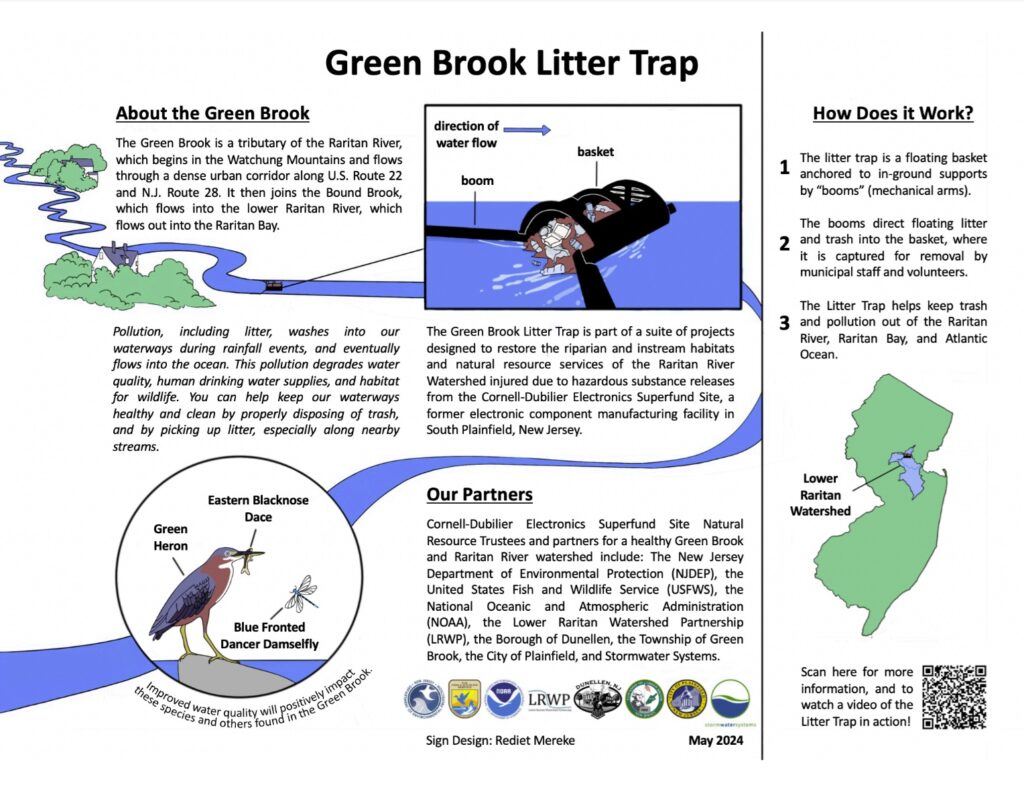Green Brook Litter Trap Installation Celebration!
On Sunday May 19th the LRWP hosted a ribbon cutting for a very special project within the Lower Raritan Watershed, a mechanical in-stream pollution reduction device installed at the Green Brook at the convergence of three towns (Dunellen, Middlesex and Plainfield) and three counties (Somerset, Middlesex and Union). The “Bandalong Bandit Litter Trap” in the Green Brook, designed and manufactured by the Georgia-based Stormwater Systems, Inc. and maintained by the Borough of Dunellen, is the first of its kind in New Jersey.

The Litter Trap project was selected for implementation as part of the Cornell-Dubilier Electronics Natural Resource Damage Assessment and Restoration (NRDAR) Restoration Plan. The Cornell-Dubilier NRDAR Plan is an example of how the nation’s strong Superfund Laws truly hold polluters accountable for environmental damages in our communities. A project seven years in the making, the LRWP appreciates the hard work and dedication of our project partners: Central Jersey Stream Team, the Boroughs of Dunellen and Green Brook, and the Cornell-Dubilier Superfund Site Trustees including the National Oceanic and Atmospheric Administration, the US Fish and Wildlife Service and the New Jersey Department of Environmental Protection. Several members of these organizations were on hand to celebrate installation of this mechanical in-stream pollution reduction device.
The “Bandit Litter Trap” is a floating cage anchored by two booms which direct floating trash into the cage where it is captured to be removed at regular intervals by municipal staff. The device is designed to simplify removal of litter from the waterway, minimizing DPW and volunteer efforts to keep our streams clean, and helping to improve water quality, environmental habitat, and human drinking water supplies. In addition to aiding in management of floatable waste in the Green Brook, the device will help us better understand the types of waste that end up in our local streams, and will help amplify community stewardship efforts for healthier urban waterways throughout the state.
In addition to LRWP Board Members Anton Getz and Heather Fenyk, LRWP Project Coordinator Clare Levourne and Project Volunteer Gregg Bucino, attending the ribbon cutting were Cornell Dubilier Superfund Site Trustee Jillian Stark with the US Fish and Wildlife Service, Dunellen Mayor Jason Cilento, Green Brook Mayor Jim Van Ardsdale, Assemblywoman Linda S. Carter, and Environmental Commissioners and Council members from surrounding towns.
Simultaneous to the ribbon cutting, over a hundred volunteers joined in the annual multi-site clean-up of the Green Brook, with clean-up activities at public parks in Dunellen, Green Brook, Plainfield and Middlesex and thousands of pounds trash were removed from the Green Brook floodplains and waterways. Trash is the most visible form of pollution in the Green Brook, and aquatic trash significantly reduces water quality, damages habitats, and causes aesthetic blight, ecological effects, economic impacts, and potential human health risks.
A key goal of the Litter Trap is to reduce the need for volunteer clean-ups, and to benefit aquatic and semi-aquatic wildlife. To better understand the impact of the Litter Trap on aquatic life going forward, from February-May 2024 the LRWP invited the Green Brook community to partner in a baseline study of American Glass Eel at an artificial eel habitat (an “eel mop”) installed approximately 100 feet upstream of the Litter Trap site. Read more about our eel study, and our findings, here. Apart from improving water quality and benefiting aquatic life, the implementation of the trap should also enhance the area’s aesthetics and improve public perception.
The Bandalong Bandit Litter Trap can operate year-round under various flow conditions without mechanical assistance, but the trash needs to be emptied at appropriate intervals, and the device must be checked after every rainfall exceeding 1 inch. It takes 2-3 months to figure out debris management and to establish a maintenance schedule. Litter surveys and collection of litter data are part of establishing this schedule, and can yield information about device impact. The LRWP will develop an outreach program for Bandalong installation in the Green Brook, including at least two public litter surveys and collection and reporting of litter data. This will involve a partial-volunteer trash removal program with training on how to measure and remove trash from the litter traps. This should also further strengthen community ties and current litter reduction efforts.
